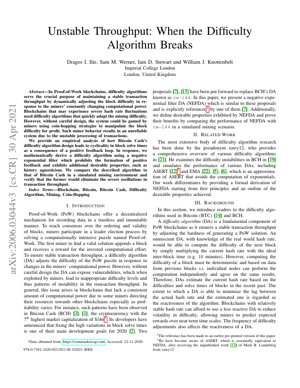Table of Contents
- 1. Gabatarwa
- 2. Ayyukan da suka danganci
- 3. Background
- 4. Technical Analysis
- 5. Experimental Results
- 6. Code Implementation
- 7. Future Applications
- 8. Nassoshi
- 9. Binciken Kwararru
1. Gabatarwa
Proof-of-Work blockchains rely on difficulty algorithms to maintain stable transaction throughput by dynamically adjusting block difficulty in response to changing computational power. Bitcoin Cash's cw-144 algorithm exhibits cyclical instability due to positive feedback loops, leading to unreliable transaction processing. This paper presents a mathematical derivation of the Negative Exponential Filter Difficulty Algorithm (NEFDA) as a superior alternative.
2. Ayyukan da suka danganci
Binciken da ya gabata na zawy12 yana ba da cikakkun bayanai game da algorithms masu wahala. An gabatar da ASERT da EMA algorithms a matsayin madadin ga cw-144. Aikinmu ya bambanta ta hanyar samar da ƙididdiga na lissafi na NEFDA daga ka'idojin farko da kuma fayyace kaddarorinsa masu kyau.
3. Background
Difficulty algorithms estimate current hash rate based on previous block difficulties and solve times. The reactiveness of an algorithm determines how quickly it can adapt to hash rate changes. Bitcoin Cash's cw-144 algorithm suffers from positive feedback loops that create cyclical patterns in block solve times.
4. Technical Analysis
4.1 Mathematical Foundation
An tsari na NEFDA an samo shi ta hanyar tacewa mai ma'ana mara kyau. Tsarin lissafi na asali shine:
$D_{n+1} = D_n \cdot e^{\frac{T_{target} - T_{actual}}{\tau}}$
Ina $D_{n+1}$ ita ce mai girma, $D_n$ ita ce girma na yanzu, $T_{target}$ shine lokacin toshe na manufa, $T_{actual}$ shine lokacin toshe na ainihi, kuma $\tau$ shine madaidaicin lokacin da ke sarrafa amsawa.
4.2 Key Properties
NEFDA yana nuna rashin sanin tarihi, yana hana samuwar ra'ayi mai kyau, kuma yana ba da saurin daidaitawa ga sauye-sauyen ƙimar hash yayin da yake kiyaye kwanciyar hankali a lokutan hako ma'adinai masu daidaito.
5. Experimental Results
Sakamakon simintin ya nuna NEFDA ta kawar da matsanancin jujjuyawar aikin ciniki idan aka kwatanta da cw-144. Algorithm din yana kiyaye lokutan toshe na hari a cikin karkatar 15% ko da a lokacin saurin canjin hash na 50%, yayin da cw-144 ke nuna karkatacciyar hanya fiye da 200%.
6. Code Implementation
function calculateNEFDA(currentDifficulty, targetTime, actualTime, tau) {7. Future Applications
NEFDA principles can be applied to emerging Proof-of-Work blockchains, particularly those experiencing significant hash rate volatility. The algorithm shows promise for decentralized storage networks, IoT blockchains, and other applications requiring stable transaction processing under fluctuating participation.
8. Nassoshi
- Ilie, D.I., et al. "Unstable Throughput: When the Difficulty Algorithm Breaks" Imperial College London (2020)
- zawy12. "Overview of Difficulty Algorithms" (2019)
- Bitcoin Cash Development Team. "BCH Difficulty Algorithm Proposals" (2020)
- Nakamoto, S. "Bitcoin: A Peer-to-Peer Electronic Cash System" (2008)
9. Binciken Kwararru
A cikin sauri kai tsaye: The difficulty algorithm design of Bitcoin Cash has a fundamental flaw. The positive feedback loop in its cw-144 algorithm leads to severe throughput instability, which directly threatens the core value proposition of blockchain—reliability and predictability.
Logical chain: The root of the problem lies in the cw-144 algorithm's excessive reliance on historical data, forming a positive feedback mechanism similar to the "herding effect" in traditional financial markets. When miners pursue profits through coin-hopping strategies, the algorithm fails to quickly adapt to changes in hashrate and instead exacerbates volatility. In contrast, the negative exponential filtering method adopted by NEFDA, akin to a PID controller in control theory, elegantly severs this vicious cycle through mathematical design.
Highlights and drawbacks: NEFDA tana da ƙwarewar tarihi maras alaƙa da saurin amsawa, wanda ke tunasar da falsafar ƙirar haɗin kai ta CycleGAN - ta hanyar ƙayyadaddun ƙayyadaddun lissafi don kaucewa fadin tsarin cikin rashin daidaituwa. Duk da haka, aikin wannan algorithm a cikin matsanancin ƙarfin lissafi yana buƙatar ƙarin tabbaci, kuma zaɓin lokacin τ yana da son rai, wanda zai iya zama sabon hanyar kai hari. Idan aka kwatanta da jinkirin bam mai wahala na EIP-3554 na Ethereum, mafita ta BCH ta fi kakkausan amma ba ta da dabarun canji sannu a hankali.
Ƙwaƙwalwar Aiki: Ga masu haɓaka blockchain, wannan binciken ya jaddada cewa ƙarfin algorithm ya fi ingantaccen aiki muhimmanci. Yin amfani da ka'idojin ƙirar sarrafawa na al'ada (kamar aikin Farfesa Karl Åström na MIT a fagen sarrafa kai) na iya kawo ci gaba ga tsarin yarjejeniya na blockchain. Ga masu zuba jari, wannan yana nufin cewa akwai buƙatar sake tantance waɗanda ake da'awar "ingantaccen aiki" amma ƙirar algorithm ɗin su na da lahani na asali. Kamar yadda rikicin kuɗi na 2008 ya fallasa gazawar samfuran kuɗi na al'ada, matsalar BCH ta tunatar da mu: a cikin tsarin da ba na tsakiya ba, ƙarfin algorithm ba zaɓi bane, amma abu ne na rayuwa.
